UP Your Career Here: AGUP.com/careers
UP Your Career Here: AGUP.com/careers

dr8 twin row planter
Planter
- 8 twin-row configuration with spacing of 36 in. or 38 in.
- Available in 2-bu. twin row MaxEmerge™ 5 row unit
- Requires large-frame row-crop tractor with 160 PTO hp
View Product Brochure
Features
Integrated innovation--that is what operators will appreciate with the SeedStar 2 monitoring system and GreenStar™ 2 (GS2) Display. An increasing number of acres combined with rising seed costs drive the need to easily understand planter functions and monitor performance. It is all about making every seed count and that is what SeedStar 2 delivers.
The SeedStar 2 monitoring system is a full-feature, color, seed population monitor used in conjunction with the GS family of displays (GS 2600 or 2630 Display or the entry-level GS2 1800 Display). Conveniently, SeedStar 2 planting functions are fully integrated with the full spectrum of AMS applications—guidance, coverage maps, and field documentation can be shown all on one GS 2600 or 2630 Display.
When a SeedStar 2 system is used on a planter, there is no need for a ComputerTrak™ monitor. All vital planting information is displayed in one central, easy-to-read location.
SeedStar 2 features
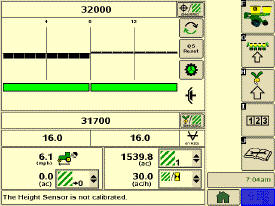 SeedStar 2 full-screen planter run page
SeedStar 2 full-screen planter run pageSeedStar 2 is a user-friendly system that has retained all the valued features of SeedStar and incorporated the next generation of enhancements. For example, on-screen, color indicators shows drive engagement/disengagement status. In addition, three color (black, orange, or red) planter at a glance bars visually inform the operator of row population status.
Not only does SeedStar 2 incorporate the use of color but it utilizes an intuitive icon and folder based operator interface. Icons are easy to understand across many languages and reduce the need for text. Icons for planter main run page, planter setup, seed/crop setup, totals, and diagnostics are located in the soft-key region of the display. Setup is performed by selecting the appropriate icon and then choosing the tabs to enter/select information.
The SeedStar 2 monitor offers all of the features and functionality of the ComputerTrak 350 monitor and much more. SeedStar 2 monitors the following planter functions:
- Row population/spacing
- Row failure
- Average population (entire planter and by variable-rate drive [VRD] motor section)
- Vacuum level
- Fertilizer pressure
- Acre counter
- Total acreage
- Tractor speed
In addition, planter operational information is available within the SeedStar 2 monitor system. Such operational information includes population charts, seed disk vacuum settings, and setting recommendations for the piston pump liquid fertilizer system.
All SeedStar 2 systems have the capability, through a single controller, to perform both the seed monitoring and variable rate drive functions. SeedStar 2 monitoring is required for VRD population control. Even though the planter may not be equipped with SeedStar 2 VRD, the SeedStar 2 monitoring system is available and will allow for future installation of VRD.
SeedStar 2 enhancements
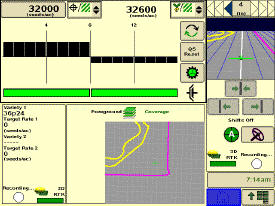 SeedStar 2 half-screen planter run page
SeedStar 2 half-screen planter run page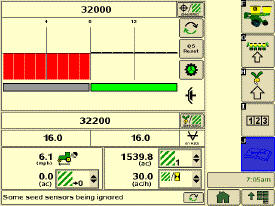 SeedStar 2 showing half-width disconnect status
SeedStar 2 showing half-width disconnect statusThe SeedStar 2 enhanced planter features include:
- GreenStar 2 display integration. Eliminates the need to operate the GS2 2600 Display in the original GreenStar monitor mode or the use of dual displays
- User-friendly, intuitive icons
- Half- or full-screen run page
- On-screen, color drive status; a quick glance at the display tells the operator if the half-width disconnect is engaged or disengaged
- Three-color planter-at-a-glance population bar. A black bar indicates that population is close to target and within established limits; orange shows the population is above/below the alarm set point; red signals the population is out of operating range or is not planting
- Three-piece, color VRD indicator. Each piece of the VRD gear pie turns green when the wheel motion sensor is active, planter is lowered, and drives are engaged
- ISO 11783. Communication standard between controllers and displays
SeedStar monitoring original features
SeedStar 2 retains all those SeedStar features that producers value and have come to expect:
- Planter at a glance. Allows operator to view relative population levels of all rows on one screen
- Automatic valve calibration. With the SeedStar VRD, this is now completed automatically. There is no longer a need to manually calibrate the hydraulic valves
- Increased population updates. SeedStar will now update population levels once a second at planter start up then approximately once every three seconds
- Mapping of actual seed rates. When combined with Field Doc™ system, actual and target seeding rates can now be mapped in Apex™ software
- Reprogrammable utilizing CAN via Service ADVISOR™ diagnostics system
- Improved diagnostics/event recorder. On SeedStar VRD planters, additional diagnostic information is available, as well as an event recorder to capture system performance data at a specific point in time
- Ability to run motors at different population levels. On SeedStar VRD, operators running multiple motor systems can run each motor at a different speed, allowing different population levels within a planter
- User-configurable high fertilizer pressure alarm. Allows the operator to be warned when fertilizer pressure reaches a specific level
- Automatic quick-start for SeedStar VRD. No longer does the operator need to press the quick-start button on end row turns to resume planting
- Automatic tractor speed source selection. When equipped with an 8000/9000 Series Tractor, the system selects the radar speed or allows for manual speed input selection
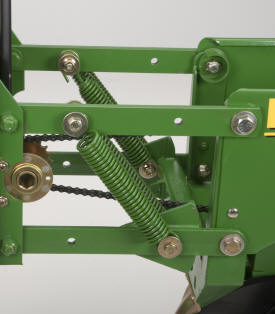 Double non-adjustable downforce springs
Double non-adjustable downforce springsDownforce springs ensure proper opener blade penetration and assist in maintaining proper seeding depth. In tilled or light soil conditions, only small amounts of downforce are needed. The non-adjustable downforce spring provides approximately 90 lb of downforce to the row unit.
If more downforce is required, a second set of non-adjustable springs may be added by sourcing parts through service parts, increasing the down force to 180 lb per row. Double non-adjustable springs are not compatible with 15-in. row spacing due to interference between adjacent parallel arms.
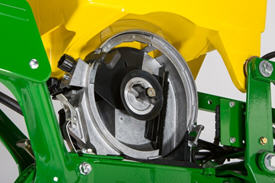 MaxEmerge™ 5 vacuum seed meter
MaxEmerge™ 5 vacuum seed meter
The vacuum meter system gently pulls and holds individual seeds to the holes of the seed disk for population control and spacing accuracy, equaling better crop stands and profit. Vacuum seed meters can plant a wide variety of crops and seed types by simply changing seed disks and adjusting vacuum level. Vacuum seed meters are available for planters with MaxEmerge™ 5 row-units.
Additional features of the vacuum seed meter include:
- One moving component (the seed metering disk) for minimum maintenance requirements
- Meter located at each row-unit for accurate seed delivery
- Good hopper seed flow characteristics for longer operating time per hopper fill
- Adjustable baffle (MaxEmerge only) to control seed flow into the seed meter reservoir, maintaining proper meter fill for the type of seed being planted
- Low airflow in meter so seed treatments are not removed
Vacuum meter seed disks
The ProMAX 40 Flat Disk: The flat-disk planting solution field-proven to work since 1991
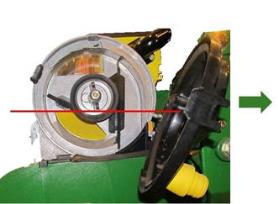 Pro-Series™ seed pool
Pro-Series™ seed pool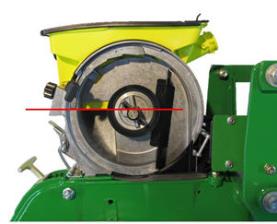 MaxEmerge 5 seed pool
MaxEmerge 5 seed poolThe MaxEmerge 5 Meter shape has also been redesigned for better seed flow. The current production mini-hopper is starved of seed when operating on side hills greater than 9 degrees. The enhancements made to the mini-hopper design with this program allow the planter to successfully operate on side hills up to 14 degrees. This correlates to the planter able to run on a 55 percent greater slope without loss in meter performance.
Vacuum meter hub and latching handle
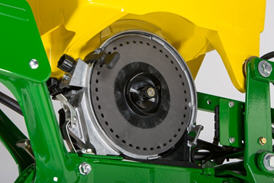 MaxEmerge 5 vacuum meter with disk
MaxEmerge 5 vacuum meter with disk
Both the MaxEmerge 5 vacuum meters are equipped with a heavy-duty hub spring and disk latching handle. The spring ensures the seed disk stays properly positioned when operating flat-style seed disks and higher vacuum levels. Proper seed disk positioning means repeatable seed singulation, time after time. The disk latching handle is designed for easy operation and effortless seed disk changeover. The hub is also machined to tight tolerances to further ensure alignment of metering components.
Operating characteristics of vacuum seed meter
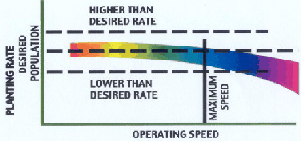 Operating speed with seed tube technology
Operating speed with seed tube technology
The vacuum seed meter is capable of operating at faster planting speeds than mechanical meters (up to 8 mph). However, planting accuracy will be influenced by seedbed conditions and the operating characteristics of the seed meter. Rough seedbeds and fast planting speeds (above 8.9 kmh [5.5 mph]) typically deteriorate seed placement accuracies when using seed tube technology.
The chart illustrates the effect operating speed has on population when using the vacuum meter. The operating band (color area) illustrates how the vacuum meter performs in relation to the desired population (indicated by horizontal line). The width of the band is due to various sizes and shapes of seeds and planting rate variations.
When operating on slopes above 15 degrees, increased or decreased population may result. To minimize this effect, reduce speed and consider using a flat style seed disk with increased vacuum level.
Vacuum blower assembly
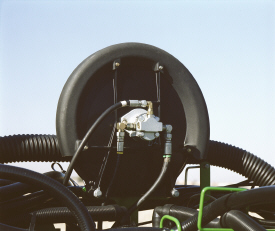 Vacuum blower shown on 1795
Vacuum blower shown on 1795
Vacuum is created by a hydraulically driven vacuum blower assembly mounted on the planter frame. The vacuum blower requires a tractor with a closed-center hydraulic system and a separate selective control valve (SCV). For tractors with open-center hydraulic system, a vacuum 540- or 1000-rpm power take-off (PTO)-driven hydraulic pump system is available. PTO pumps offered from the factory are limited to 15 row applications or less. For applications of 16 rows or more, contact a John Deere dealer.
Vacuum blower assembly capabilities and reliability continue to improve with time. The increased reliability of today's vacuum blowers (since 2006) can be attributed to a larger displacement case drain motor (3.5 cc vs. 2.2 cc) driving a larger diameter blower fan of 47-cm vs. 44-cm (18-5/8 in. vs. 17 3/8-in.) that runs at a slower speed, providing the same amount of vacuum pressure at the seed meter. Another advantage of the larger-diameter fan and larger-displacement case drain pump is that it eliminates the need for a second vacuum blower assembly on a 12-row planter when using a flat seed disk. Current vacuum motors are capable of providing vacuum for 12 row-units running flat disks, or 16 row-units running celled disks.
Different vacuum levels are required depending on the crop to be planted. A hydraulic control valve lets the operator regulate vacuum blower speed, thus changing the vacuum level. On late model John Deere tractors, vacuum levels are set from the tractor seat using the SCV TouchSetTM controls. The control valve is not needed. At full flow, the system flows up to five gpm per motor. Only very large seed or flat seed disks require this much flow.
Convenient vacuum gauges located on the planter hitch give a visual indication of the vacuum level. When using a SeedStar™ monitor, the vacuum level can be displayed on the monitor. Consult the vacuum metering seed charts in the operator's manual for initial vacuum setting recommendations.
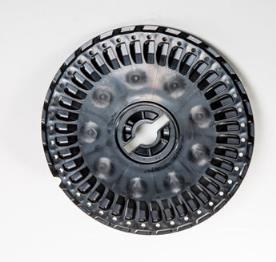

John Deere has been making this flat disk since 1991. The ProMAX 40 Flat is designed as a component of the entire John Deere VacuMeter™ system with the intention that the producer will not have to buy a hopper to make it work.
The design of the ProMAX 40 Flat, as well as the positioning of the disk within the meter, allow seed to be released from the optimum position above the seed tube. The Flush-Face seed tube allows seed to drop uninterrupted through the tube, so every seed is properly released into the tube, and every seed clears the tube with even spacing.
The ProMAX 40 Flat does not have cupped cells to help carry the seed, but rather utilizes flat holes and a higher vacuum level to ensure every hole is populated with one or more seeds. A double eliminator gently removes all but one seed at each hole for precise population control. A knockout wheel makes certain that each hole is clear of any debris after the seed is released from the disk.
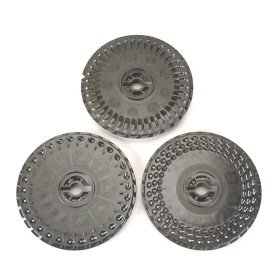 Flat-style and cell seed disks shown
Flat-style and cell seed disks shown
Seed disks are made of a durable plastic composition. The unique cell disk design allows planting a variety of seed sizes without any additional parts or individual meter adjustments. Another advantage of cell-type seed disks is the lower vacuum requirement compared to flat-style seed disks. Lower vacuum levels mean less hydraulic demand from the tractor.
Both the MaxEmerge and Pro-Series vacuum seed meters can also utilize flat-style seed disks. These disks are recommended in crops where seed is typically difficult to singulate due to inconsistent seed size or shapes, or on slopes where achieving target populations can be difficult. Flat seed disks do not have a cell to help carry the seed, and thus require higher levels of vacuum to meter seed. Flat-style seed disks do require additional meter components to operate.
Double eliminator
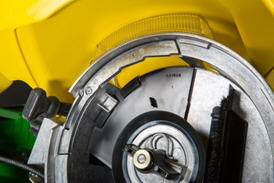

A double eliminator and knockout wheel assembly is needed to singulate seeds when using a flat seed disk. The knockout wheel is installed in place of the wiper used with celled disks.
The MaxEmerge 5 vacuum meter has an external, adjustable double eliminator. This double eliminator uses a knob with numbers to indicate where it should be set for different crops. This feature makes achieving a high level of singulation easier and more consistent.
The adjustment knob is capable of 21 unique positions. The dial is numbered zero through ten in increments of one, but the gearing allows for half increment adjustments as well.
Adjustment time for this double eliminator is estimated to be 10 seconds per row unit, with repeatable results. This means that adjustment can be made three times faster than Pro-Series XP™ units, and eight times faster than MaxEmerge XP units.
Flat and celled type seed metering disks are available to allow planting a wide variety of seed types.
- Corn (field, popcorn or sweet corn)
- Soybeans
- Cotton
- Sorghum
- Sugar beets
- Sunflowers
- Edible beans/peas
- Peanuts
- Melons, squash, cucumbers
Mini-hopper row-units, which are used only with the Central Commodity System (CCS™) are compatible only with crops that the CCS is approved to plant.
- Corn
- Popcorn
- Sweet corn
- Soybeans
- Sunflowers
- Sorghum
- Cotton
NOTE: Due to small seed size and low planting populations, sugar beets can be planted with mini-hopper style meters by adding hopper extensions and not using the CCS tank. These hopper extensions can also be used for planting test plots.
IMPORTANT: Proper seed disk selection is essential for optimum seed meter performance.
Vacuum meter case drain
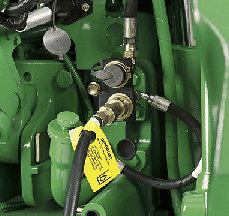 Case drain coupler 7000 Series Tractor
Case drain coupler 7000 Series Tractor
All planters with vacuum metering systems have case drain motors on the vacuum blowers. As of May 2004, all case drain lines will have a flush-face case drain coupler on the planter and will require a corresponding flush-face case drain coupler on the tractor. The flush-face coupler simplifies implement attachment by allowing operators to easily identify the case drain. The unique hose tip is unable to hook into another coupler on the tractor, ensuring the correct setup.
It is important to hook up this case drain hose to prevent the continuous and complete draining of hydraulic fluid due to the relief feature that opens the coupler when the pressure reaches 10 psi. This relief feature is designed to protect the motor shaft seal if for any reason the case drain hose was not connected to the tractor. The flush-face hose tips have less back pressure than International Organization for Standardization (ISO) case drain tips, and the flat surface makes these couplers easy to clean, providing less chance for contamination.
The case drain line is also used with all CCS fan motors.
Seed variable-rate drive provides the ultimate planting productivity by utilizing one, two, or three hydraulic motors (varies by model) to turn the seeding drive shaft. Hydraulic control of the seeding drive allows for on-the-go seeding rate changes right from the display mounted inside the tractor cab. Combine this seeding flexibility with the map-based planting option, and seeding rates adjust automatically based on the prescribed map.
Variable-rate drive offers the following advantages over common, ground, or contact-tire drive systems:
- Rate changes are almost instantaneous; no ramp up or ramp down of system as in some competitive systems
- Permits the producer to match seed population based on different soil types or irrigation practices
- John Deere design provides added operator safety by eliminating any possible drive creep found in some competitive variable-rate drive systems
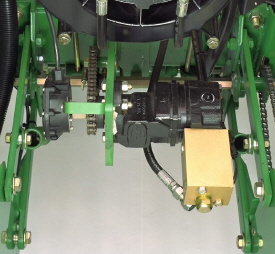 1755 equipped with variable-rate drive
1755 equipped with variable-rate drive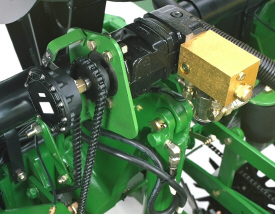 1765NT equipped with variable-rate drive
1765NT equipped with variable-rate driveSingle- or dual-motor systems for variable-rate drives are available for all John Deere planters except the 1785 Rigid Frame. Variable-rate drive is available as a factory-installed option for all applicable planter models.
Single- or dual-motor systems are available as field-installed attachments for most planter models; however, a three-motor variable-rate drive field-installed attachment is not available.
Seed variable-rate drive requires the SeedStar™ monitor and a radar input signal. Either tractor or planter radar may be used. Planter radar is ordered separately.
NOTE: Peanut seed meter disks require the Variable Drive Transmission.
Pneumatic downforce provides convenient, simple adjustment of downforce for the whole planter from one location. The amount of downforce applied is infinitely adjustable from 0 kg to 181.80 kg (0 lb to 400 lb). Pneumatic downforce provides more consistent downforce throughout the range of row-unit travel than mechanical spring downforce systems.
For model year 2011, several pneumatic downforce system improvements were implemented. Such improvements are:
- 9.5-mm (3/8-in.) air delivery line instead of the 6.4-mm (1/4-in.) line used on model year 2010 and older planters.
- Improved air compressor assembly increased duty cycle. With this new compressor, it provides a 47 percent increase in maximum air flow delivery compared to the prior air compressor.
- New pneumatic air bags with 9.5-mm (3/8-in.) air line inlets that have improved connecting points for greater durability.
Such improvements to the pneumatic downforce system will enable for faster and more precise control of row-unit downforce while planting.
System features
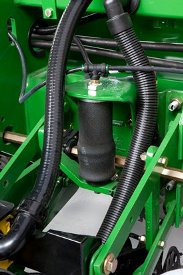 Pneumatic downforce spring
Pneumatic downforce spring
Each row-unit has a single, rubber air bag located between the parallel arms. The air bags are hooked in parallel so that air can be added or released from all rows at once from one location.
Pneumatic downforce systems are available as base equipment on all 1700 Series and DB planters. The individual pneumatic downforce air bag assemblies, air compressor units, and 9.5-mm (3/8-in.) delivery lines are also available as an attachment for field conversion.
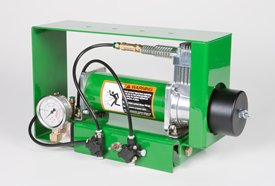 Pneumatic downforce compressor and gauge
Pneumatic downforce compressor and gauge
An improved compressor is used to charge the pneumatic system. This compressor can be located on the planter frame or in the tractor cab if desired. A gauge at the compressor indicates the amount of downforce being applied.
From the factory, integral planter models with pneumatic downforce will have an improved air compressor assembly with an in-cab mounting bracket, except the 1725 16-row and 1725 Central Commodity System (CCS™ ) TR Planters will have the air compressor assembly mounted on the planter frame. For drawn planter models, the 1755, 1765, 1765NT, 1775 Front-Fold, and 1785 Drawn Planters will have the air compressor assembly installed either on the outer hitch or wing frame members when the pneumatic downforce system is installed.

